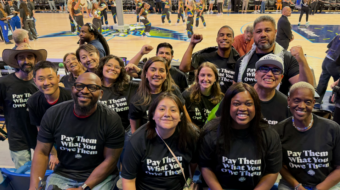
(PAI) First Lady Eleanor Roosevelt once said, “There are only two ways to bring about protection for workers… legislation and unionization.”
The basic human right of workers to “freedom of association with others, including the right to form and join trade unions for the protection of his/her interests” was ratified by the United States in 1992 as an International Covenant on Civil and Political Rights.
Yet throughout the country today, public employees, nurses, teachers, librarians, social workers, firefighters, etc. are being threatened with a right-wing assault to destroy their way of life by eliminating collective bargaining and other rights under the guise of fiscal responsibility. This is a smokescreen for an all out attack on the right to form unions and to bargain collectively for a better life for oneself and one’s family.
Thousands of protestors, workers and their community allies have joined together to express their outrage in states throughout the country.
Women in particular have a special interest in standing in solidarity with workers whose basic right to advocate for a better life is under assault.
According to a study by the Institute for Women’s Policy Research, women are 51 percent of the state public sector workforce and 61 percent of employees working in local government. Public sector unions like the American Federation of State, County, and Municipal Employees and the American Federation of Teachers have a majority female membership (52 percent and 60 percent respectively) and the outcome of the assault on public employees will have an enormous impact on these workers.
Women are in the majority in a number of professions represented in the public sector; for example, 80 percent of teachers are women and 95 percent of nurses are women.
Overall, the typical full-time woman worker does not earn as much as a man in any state. However, according to a December 2008 study by the Center for Economic Policy Research, unionized women workers were found to earn, on average, 11.2 percent more than their non-union peers.
Today, nearly 6.9 million working women are union members and over 7.7 million are represented by unions. According to the Bureau of Labor Statistics, in 2010 7.6 million public sector employees belonged to a union with 7.1 million union workers in the private sector.
In 2007, women made up 45 percent of union members and if they continue to grow at the rate of the last 25 years, women will be the majority of the unionized workforce by 2020.
A recent study by the Center for Economic and Policy Research found that for the years 2004-2007 unionized women were much more likely to have health insurance (75.4 percent) and a pension (75.8 percent) than women workers who were not in unions. (50.9 percent for health insurance, 43 percent for pensions)
Unions increase workers’ access to childcare by creating childcare centers in the workplace, lobbying for childcare subsidies and providing workers with childcare benefits through collective bargaining agreements.
Unions provide workers with job security when they need to respond to family care emergencies.
Unions give workers the right to alternative work arrangements such as flexible hours and telecommuting, which allows workers to balance family and childcare needs.
Union members receive 14 percent more paid time off than non-union employees.
So we see that women have a special stake in the battles being waged in states throughout the country. We know when you improve the lives of women you improve the lives of families.
The Coalition of Labor Union Women is proud to stand in solidarity with, and to support, our sisters and brothers who serve this country in state or federal government jobs as well as those in private sector jobs. We will stand and work with them to retain and improve their right to associate with others and to form unions in order to improve their lives and the lives of their families.
Karen J. See is the president of the Coalition of Labor Union Women. Photo: Judy Baxter // CC 2.0










